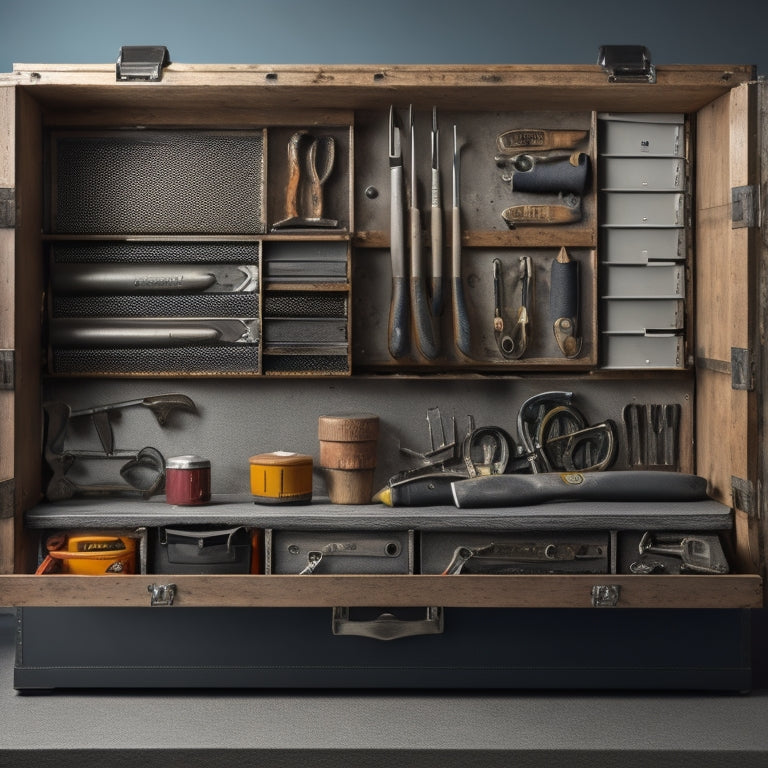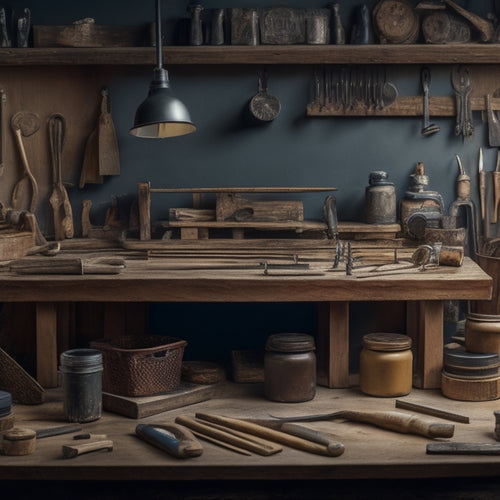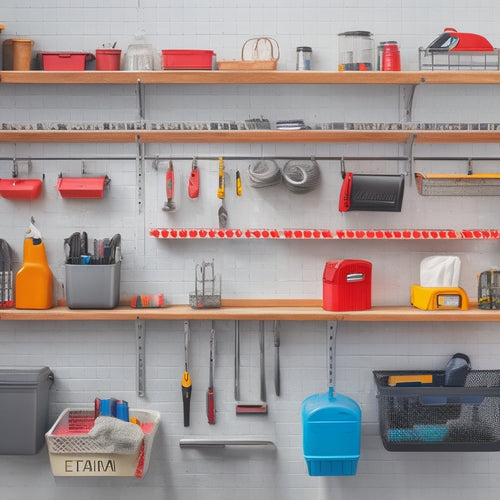
5 Simple Steps to Create a Tool Chest Tool Organizer System
Share
You're just five simple steps away from a highly efficient tool chest organizer system. First, assess your tool collection by categorizing tools, evaluating frequency of use, and determining condition and importance. Next, measure your tool chest space, noting obstructions and recording tool dimensions to inform storage solutions. Then, choose an organizer system based on tool types and storage needs, considering frequency of use, size, and weight. After that, install the organizer components, prioritizing safety and following manufacturer guidelines. Finally, organize and refine your tools, assigning designated spots and implementing maintenance routines - and get ready to access the full potential of your newly organized workspace.
Key Takeaways
- Assess your tool collection by categorizing, evaluating frequency of use, and determining condition and importance to inform your organizer system.
- Measure your tool chest space, noting obstructions, to determine the optimal storage solution and ensure a tailored fit.
- Choose a tool organizer system that accommodates your tool types, storage needs, and frequency of use, with customizable components for flexibility.
- Install the organizer components securely, following manufacturer guidelines, and prioritize safety throughout the process.
- Organize and refine your tools by categorizing, assigning designated spots, and implementing maintenance routines to enhance accessibility and efficiency.
Assess Your Tool Collection
Your tool collection has grown over the years, and it's likely a mix of essentials and nice-to-haves. Take a closer look at what you've accumulated and categorize tools by type, such as hand tools, power tools, and accessories. This will help you identify what you have, what you need, and what you can get rid of.
Consider the frequency of use, condition, and importance of each tool. Separate your tools into groups, like daily use, occasional use, and seasonal use. This will give you an idea of what storage solutions you'll need.
For instance, frequently used hand tools might require easy access and dedicated storage, while seasonal tools can be stored in less accessible areas. Make a mental or written note of the tool types and the storage solutions you'll need.
This assessment will help you create a functional and efficient tool chest organizer system that meets your specific needs.
Measure Your Tool Chest Space
Now that you've assessed your tool collection and categorized them by type and frequency of use, it's time to turn your attention to the tool chest itself. Measure the interior and exterior dimensions of your tool chest, including the height, width, and depth of each shelf and compartment.
Take note of any obstructions, such as hinges or handles, that may affect your storage options. Record the tool dimensions of your largest and smallest tools to guarantee you have enough space for each item.
Consider the storage options you'll need, such as bins, trays, or dividers, to keep your tools organized and easily accessible. Don't forget to measure the doors and drawers to determine the maximum size of storage containers you can use.
Accurate measurements will help you create a customized tool organizer system that maximizes your tool chest's storage capacity and keeps your tools safe and organized.
Choose a Tool Organizer System
With your tool chest's measurements in hand, it's time to choose a tool organizer system that fits your specific needs. Consider the types of tools you'll be storing, as this will help you decide on the best storage solutions.
Think about the frequency of use, size, and weight of each tool. Will you need separate compartments for small items like screws and nuts, or larger bins for power tools?
Look for a system that offers customizable components, such as adjustable shelves, bins, and dividers. This will allow you to create a personalized space for each tool type, ensuring easy access and preventing clutter.
Consider the material and durability of the organizer system, as well as any safety features, like anti-slip coatings or secure latches.
Research different tool organizer systems, reading reviews and product descriptions to find the one that best suits your tool chest's dimensions and your specific needs.
Don't be afraid to mix and match components from different systems to create a customized solution. By taking the time to choose the right tool organizer system, you'll be able to create a safe, efficient, and organized workspace.
Install the Organizer Components
After selecting the ideal tool organizer system, it's time to bring your vision to life by installing the components. Start by preparing your workspace, making certain it's clean, dry, and free from any obstructions.
Next, carefully unpack the organizer materials, taking note of the instruction manual and any specific mounting techniques required for each component.
Begin by installing the main structure, following the manufacturer's guidelines for secure attachment to your tool chest. Use appropriate fasteners, such as screws or bolts, to guarantee a sturdy foundation for your organizer system.
Then, add the dividers, shelves, and bins, utilizing the recommended mounting techniques to prevent damage or instability.
Throughout the installation process, prioritize safety by wearing protective gear, like gloves and safety glasses, and maintaining a stable work environment.
Double-check each component's placement and securement to avoid any potential hazards or accidents.
Organize and Refine Your Tools
You've successfully installed the tool organizer components, and your workspace is starting to take shape.
Now, it's time to organize and refine your tools. Begin by sorting your tools into categories, such as hand tools, power tools, and fasteners. This will aid you in determining the most effective storage solutions for each type.
Assign a designated spot for each tool, guaranteeing easy accessibility and minimizing clutter. Implement maintenance routines, like regular cleaning and lubrication, to extend the life of your tools.
For frequently used tools, consider assigning a "home" location near your workspace to enhance efficiency.
Inventorize your tools and update your inventory tracking system to verify you have the right tools for future projects. This will also help you identify tools that need replacement or calibration.
Frequently Asked Questions
Can I Customize the Tool Organizer System for My Specific Tool Collection?
You can definitely customize the tool organizer system to fit your specific tool collection, exploring various customization options to accommodate unique tool types, ensuring a safe and efficient storage solution that meets your exact needs.
How Do I Prevent Tools From Getting Rusty in the Organizer?
Silky surfaces surrender to savvy rust prevention methods; you'll shield your tools by ensuring dry docking, using desiccant packets, and applying a rust-inhibiting coating, thereby mastering moisture control techniques to keep your tools tarnish-free and ready for action.
Are Tool Organizer Systems Suitable for Portable Tool Chests?
You'll find tool organizer systems perfect for portable tool chests, as they enhance organization efficiency and provide secure portable storage, ensuring your tools stay protected and within reach, no matter where you work.
Can I Use a Tool Organizer System in a Small Workshop?
Ha! You think a small workshop means a tool organizer system is out of the question? Think again! You'll appreciate the space management benefits even more in a compact workspace, keeping tools within easy reach and preventing accidents.
Are Tool Organizer Systems Compatible With All Tool Chest Brands?
You'll find that most tool organizer systems are designed to be versatile, accommodating various tool chest brands and models, but it is crucial to check compatibility before purchasing, considering brand variations and ensuring a secure, safe fit for your specific tool chest.
Conclusion
Now that you've built your tool organizer system, it's time to reap the benefits! Your tool chest is changed into a well-oiled machine, where every tool has its designated spot, waiting to be called into action. Think of it as a precision-crafted orchestra, where each instrument is finely tuned and ready to harmonize with the others. With this system, you'll be conducting projects with ease, efficiency, and precision.
Related Posts
-

10 Essential Steps for Small Parts Bin Storage
To optimize your small parts bin storage, start by defining your storage needs and goals, considering factors like av...
-

Top 5 Small Tool Organizers for Your Workshop
You're looking to optimize your workshop's efficiency with high-quality small tool organizers. Compact storage soluti...
-

3 Simple Steps to a Garage Tool Wall You'll Love
To create a garage tool wall you'll love, start by planning the space, taking inventory of your tools, and measuring ...


